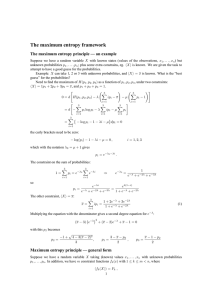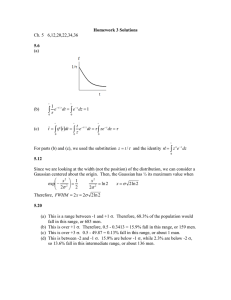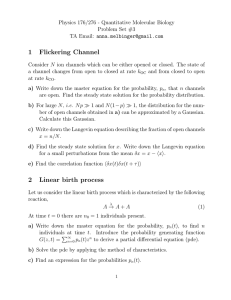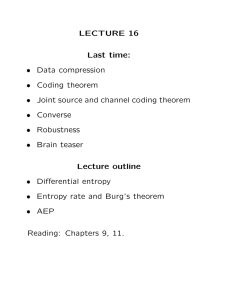1 Probability Distributions : Summary
advertisement
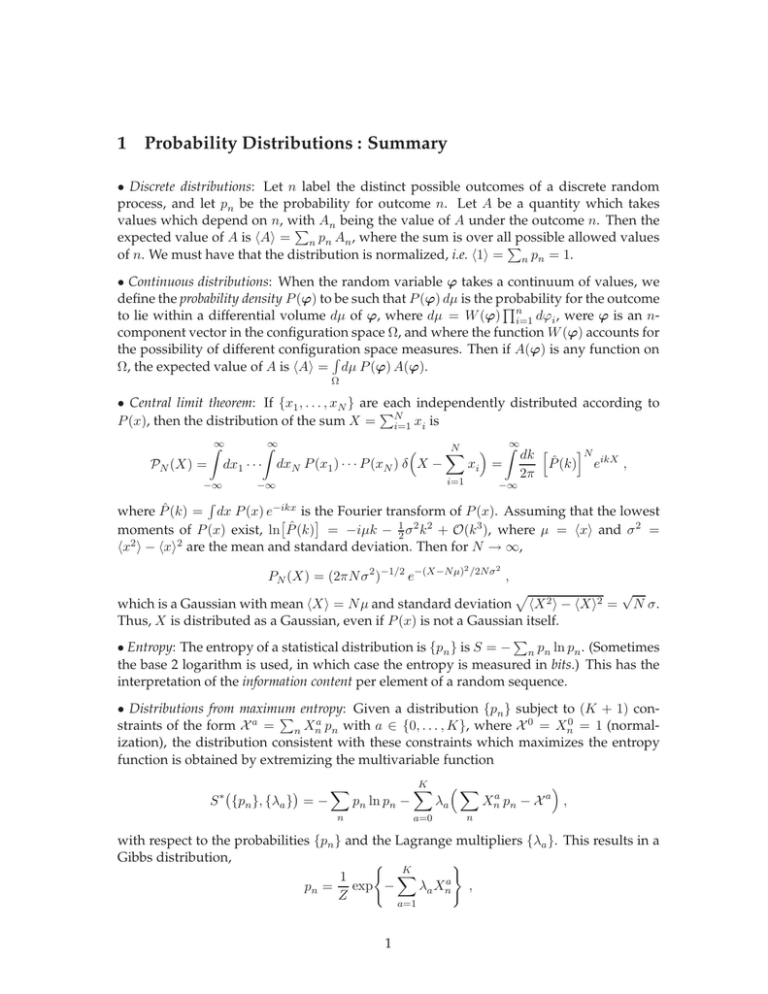
1 Probability Distributions : Summary
• Discrete distributions: Let n label the distinct possible outcomes of a discrete random
process, and let pn be the probability for outcome n. Let A be a quantity which takes
values which depend on n, with
P An being the value of A under the outcome n. Then the
expected value of A is hAi = n pn An , where the sum is over allPpossible allowed values
of n. We must have that the distribution is normalized, i.e. h1i = n pn = 1.
• Continuous distributions: When the random variable ϕ takes a continuum of values, we
define the probability density P (ϕ) to be such that P (ϕ) dµ is the probability
for the outcome
Q
to lie within a differential volume dµ of ϕ, where dµ = W (ϕ) ni=1 dϕi , were ϕ is an ncomponent vector in the configuration space Ω, and where the function W (ϕ) accounts for
the possibility of different configuration
space measures. Then if A(ϕ) is any function on
R
Ω, the expected value of A is hAi = dµ P (ϕ) A(ϕ).
Ω
• Central limit theorem: If {x1 , . . . , xN } are each independently distributed according to
P
P (x), then the distribution of the sum X = N
i=1 xi is
Z∞
Z∞
N
iN
Z∞ dk h
X
P̂ (k) eikX ,
xi =
PN (X) = dx1 · · · dxN P (x1 ) · · · P (xN ) δ X −
2π
−∞
i=1
−∞
−∞
R
where P̂ (k) = dx P (x) e−ikx is the Fourier transform of P (x). Assuming that the lowest
moments of P (x) exist, ln P̂ (k) = −iµk − 12 σ 2 k2 + O(k3 ), where µ = hxi and σ 2 =
hx2 i − hxi2 are the mean and standard deviation. Then for N → ∞,
2 /2N σ 2
PN (X) = (2πN σ 2 )−1/2 e−(X−N µ)
,
p
√
which is a Gaussian with mean hXi = N µ and standard deviation hX 2 i − hXi2 = N σ.
Thus, X is distributed as a Gaussian, even if P (x) is not a Gaussian itself.
P
• Entropy: The entropy of a statistical distribution is {pn } is S = − n pn ln pn . (Sometimes
the base 2 logarithm is used, in which case the entropy is measured in bits.) This has the
interpretation of the information content per element of a random sequence.
• Distributions from maximum
P entropy: Given a distribution {pn } subject to (K + 1) constraints of the form X a = n Xna pn with a ∈ {0, . . . , K}, where X 0 = Xn0 = 1 (normalization), the distribution consistent with these constraints which maximizes the entropy
function is obtained by extremizing the multivariable function
K
X
X
X
Xna pn − X a ,
λa
S ∗ {pn }, {λa } = −
pn ln pn −
n
a=0
n
with respect to the probabilities {pn } and the Lagrange multipliers {λa }. This results in a
Gibbs distribution,
)
( K
X
1
λa Xna ,
pn = exp −
Z
a=1
1
P
where Z = e1+λ0 is determined by normalization, i.e. n pn = 1 (i.e. the a = 0 constraint)
and the K remaining multipliers determined by the K additional constraints.
• Multidimensional Gaussian integral:
Z∞
Z∞
(2π)n 1/2
1
b
exp 12 bi A−1
dx1 · · · dxn exp − 2 xi Aij xj + bi xi =
ij j .
detA
−∞
−∞
• Bayes’ theorem: Let the conditional probability for B given A be P (B|A). Then Bayes’ theorem says P (A|B) = P (A) · P (B|A) / P (B). If the ’event space’ is partitioned as {Ai }, then
we have the extended form,
P (B|Ai ) · P (Ai )
P (Ai |B) = P
.
j P (B|Aj ) · P (Aj )
When the event space is a ‘binary partition’ {A, ¬A}, as is often the case in fields like
epidemiology (i.e. test positive or test negative), we have
P (A|B) =
P (B|A) · P (A)
.
P (B|A) · P (A) + P (B|¬A) · P (¬A)
Note that P (A|B) + P (¬A|B) = 1 (which follows from ¬¬A = A).
2

